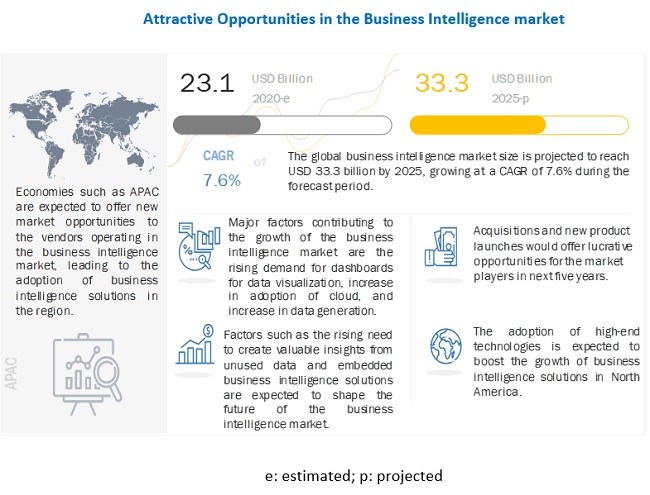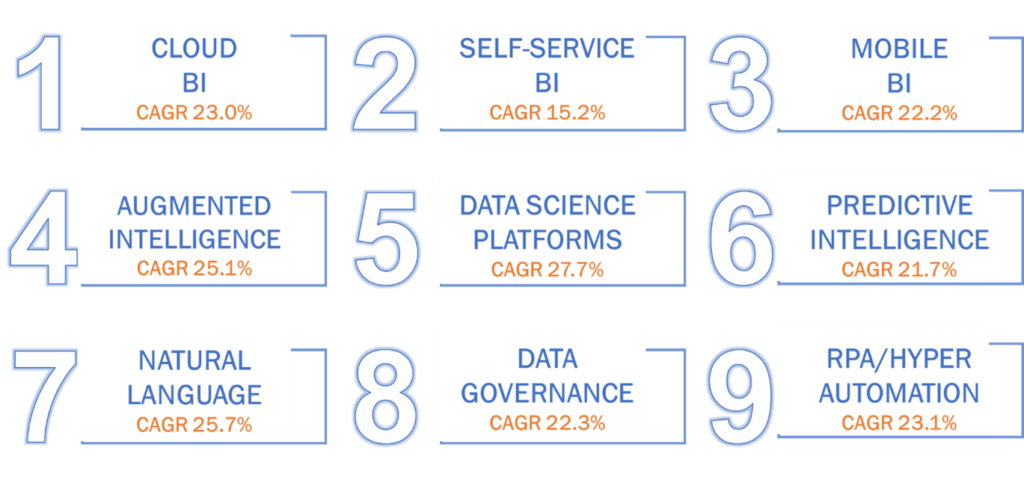Introduction
The adoption of business intelligence (BI) tools is expected to continue to rise with a CAGR of 7.6% to reach USD 33.3 billion by 2025, with more businesses realizing the importance of effective data management and its role in driving insight-based decision-making processes.
FIGURE 1: ATTRACTIVE OPPORTUNITIES IN THE BUSINESS INTELLIGENCE (BI) MARKET

With data generated from multiple sources and its increasing importance in business operations, organisations can effectively utilise data and insights in their day-to-day decision-making. BI solutions can offer many benefits – from enhancing financial visibility, and improved reporting to better business decisions. BI also significantly impacts sales and can help companies increase revenue and gain a competitive edge.
Here are some of the significant trends that will shape the enterprise BI landscape:
FIGURE 2: MEGATRENDS SHAPING THE ENTERPRISE BI LANDSCAPE
Source: MarketsandMarkets analysis
Cloud BI/ Analytics
The COVID-19 pandemic forced companies to look hard at their existing BI strategies. On-premises solutions couldn’t measure up to the challenge of a largely remote workforce, and companies realigned their budgets to make room for migration to cloud BI and analytics platforms. Businesses now consider analytics a mission-critical capability, and companies aren’t shying away from adopting data solutions.
Mike Brody, CEO of Exago, a software vendor for embedded BI for SaaS providers, said their company adapted quickly to the transition to remote work — in fact, it’s thriving. Among upcoming business intelligence trends, there will be greater demand for industry-specific BI solutions in banking, manufacturing, healthcare, security services, and many other industries globally.
Self-Service BI
In recent years, companies have realized that timely BI insight is critical to make informed business decisions. They want data to guide them in every step. They are also aware of the need to equip their employees with data querying and interpretation skills. Here Self-service BI has a vital role to play. It drives data literacy across industries as companies acknowledge the benefits of delegating BI tasks to employees.
Among future trends in business intelligence, we foresee an increased enterprise push for data literacy with significant investment in self-service tools and techniques and employee training.
Mobile BI
Mobile intelligence is a business-critical component that includes audio, videos, images, text, and streaming data. The information is considered invaluable by different teams within an organization. It helps product managers to develop mobile applications; technical teams use it to optimize app performance. Web designers create intuitive interfaces and user-friendly workflows from usage trends, and marketing teams use mobile BI to attract new leads, expand their user base and optimize the customer experience.
Mobile BI brings many benefits to day-to-day business operations. It brings about greater availability of data to users, faster reaction speed to events, more efficient working, improved internal communications, and shortened workflows.
Major growth drivers include the increasing BYOD trend, the importance of mobile enterprise application platforms (MEAP), data-driven decision-making, the proliferation of in-memory computing, and customer experience management.
Recently, Uber, PayPal, Snap, Block had all endorsed the idea of a SuperApp, and Elon Musk discussed the concept of a SuperApp in a recent interview. Most SuperApps contain social features, e-commerce marketplaces, financial services, transportation services, messaging capabilities and delivery services. SuperApp technology is anticipated to support Internet of Things (IoT) technologies, chatbots, and immersive experiences. Such industry developments making their way into the B2B enterprise environments could boost the adoption of mobile BI solutions globally.
FIGURE 3: SUPERAPP: INTEREST AND BUSINESS MODEL

Augmented Intelligence
Integrating technologies like AI and machine learning makes it easier for businesses to harness the power of business intelligence. In combination with advanced analytics, automation, and cloud technologies, augmented intelligence has transformed how enterprise leaders and their teams keep up with the rapid pace of business disruption.
Augmented intelligence goes beyond self-service BI tools due to its machine learning capabilities, natural language processing, and automated insights. With augmented intelligence, raw data can be easily refined into actionable insights to fuel data-driven business decisions.
For instance, AI automates work and helps workers in the manufacturing industry to augment and amplify their intelligence and improve safety, quality, and productivity, driving digital transformation efforts across various industry verticals. Similarly, augmented intelligence is helping different industry verticals in multiple ways:
It assists retailers in capitalizing on customers’ shifting needs.
In the financial services industry, it is helping to acquire, retain, and serve the customer better.
It assists airlines in acting on customer preferences and world events.
In hospitality, it is driving revenues through optimized pricing
It is helping telecommunications stay competitive with an evolving customer base
In healthcare, optimizing operations for better patient outcomes.
Data Science/ Platforms
As per MarketsandMarkets analysis, the global data science platform market is expected to reach USD 322 billion by 2026, growing at a CAGR of 27.7% during the forecast period. The primary growth drivers include astonishing growth in big data, rising adoption of cloud-based solutions, and the increasing need to extract in-depth insights from voluminous data to gain a competitive edge.
As per industry experts, 2023 will be a massive year for data science and AI. The focus area in the overall AI market will include everything from NLP to RPA, and with data growing at an exponential pace, there will only be a surge in the growth.
Some notable trends in data science that will boost its overall adoption:
TinyML and Small data – TinyML algorithms are designed to consume the least amount of space possible and run on low-powered hardware. Embedded systems, including home appliances, wearables, cars, agricultural machinery, and industrial equipment, will use TinlyML. Applications include object recognition and classification, gesture recognition, keyword spotting, machine monitoring, and audio detection.
Data-driven customer experience – Businesses will increasingly use data to extract valuable insights to provide an enjoyable experience to their customers. For instance, from AI chatbots to Amazon’s cashier-less stores the, more interactions become increasingly digital, businesses can measure and analyse every aspect of the interaction to improve various processes.
Convergence – With the convergence of AI, cloud computing, IoT, 5G, and data as fuel, these converged technologies can do much more than they can separately. Smart homes, smart factories, and smart cities are a few examples of the various use cases and applications enabled with these technologies.
AutoML – A trend that is causing the democratizing of ML. Simple user interfaces that keep the inner working of ML out of sight, so that anyone who wants to test a problem can easily apply ML.
Predictive Intelligence
Predictive intelligence is used to identify opportunities and challenges for a business. Businesses will recognize more compelling use cases for predictive intelligence, and it will play a more critical role in the business intelligence ecosystem
Predictive intelligence allows companies to forecast the outcomes of present market conditions and operations, allowing owners to make well-informed decisions. It helps organizations optimize their internal processes, improve client satisfaction, manage budgets, identify new market opportunities, and anticipate external events’ impact. Thereby providing companies with deeper visibility into operations and helping improve business outcomes.
The predictive intelligence market is highly competitive, with numerous players in different phases of the ecosystem. According to MnM’s market evaluation framework, most companies are adopting organic growth strategies to strengthen their market position. Microsoft, IBM, SAP SE, Oracle, SAS Institute, Google, Salesforce, AWS, HPE, Teradata, Alteryx, FICO, and Altair are a few key market players offering innovative predictive analytics solutions and services.
Natural Language
Using natural language processing (NLP) in is helping companies to democratise data and make sense of unstructured and semi-structured data. As technology gets better at understanding human language and the context of the queries, NLP will continue to drive the acceptability of the increasing importance of business intelligence in the future.
According to data scientist and Chief Science Officer at DataPrime, Dr. Kirk Borne, “NLP applications are increasing. These include conversational AI (chatbots) in contact call centers and other consumer-facing engagements; unstructured text analysis (such as topic detection, sentiment analysis, document summarization, and link analysis across document collections); and voice-assisted BI applications, including voice-driven dashboards and question-answering BI tools. I see a strong ‘friendly’ competition between computer vision and NLP to become the dominant AI application in organizations. Consequently, this will stimulate both AI technologies to greater adoption and even more applications.”
Natural language processing (NLP) is among the top BI trends currently, and it holds tremendous potential in the future of business intelligence.
Data Governance
Governance compliance is a legal mandate, and BI tools with built-in access protocols will have the edge over others. Regulations like the General Data Protection Regulation (GDPR) are significant because they enforce data protection rules and give greater control over how third parties use personal information. Governance is critical for industries that directly impact public health and safety, like financial services, insurance, healthcare, and defense. A readymade governance framework helps secure data per industry standards. Strict oversight and penalties ensure organizations are serious about compliance.
According to a 2022 Zaloni survey of data governance professionals, data quality (74%) and analytics/BI (57%) were the primary reasons for increased investment in data governance. In efforts to make data more accessible, data governance tools increasingly incorporate policy and stewardship management capabilities, thus simplifying access for various user roles. Additionally, BI software with built-in role-based permission controls and authentication protocols will be in demand.
Data quality efforts are another big trend in data governance, and many organizations are building holistic data strategy to keep up with regulatory compliance. It has become even more critical for enterprises to achieve improved data quality. As Zaloni’s survey revealed, it is the primary factor motivating enterprises to get serious about data governance.
RPA/ Hyper-Automation
BI helps businesses automate several tedious and time-consuming tasks. Using multiple tools and technologies like AI and machine learning along with low-code and no-code approaches, it has become possible for businesses to rely on business intelligence for data automation.
Automation speeds up delivery pipelines as analytics scales up with increasingly complex data volumes. ML-driven algorithms are faster, providing automated responses to searches and triggering event-driven workflows. The evolving capabilities of business intelligence platforms will continue to play an integral role in automation, and companies will be able to achieve hyper-automation modes for several operational requirements. Hyper-automation is a key factor in digital transformation as it eliminates human intervention in low-value processes, helping organizations adapt to change rapidly.
Highly competitive sectors like finance have already embraced hyper-automation strategies. Organizations that use remote process automation are just a few steps away from hyper-automation, so they should look towards integrating artificial intelligence and machine learning into the automation framework to reap the benefits of hyper-automation.